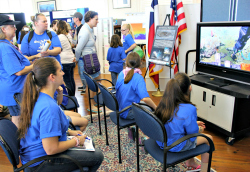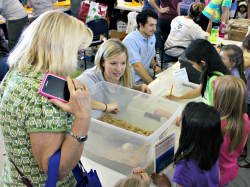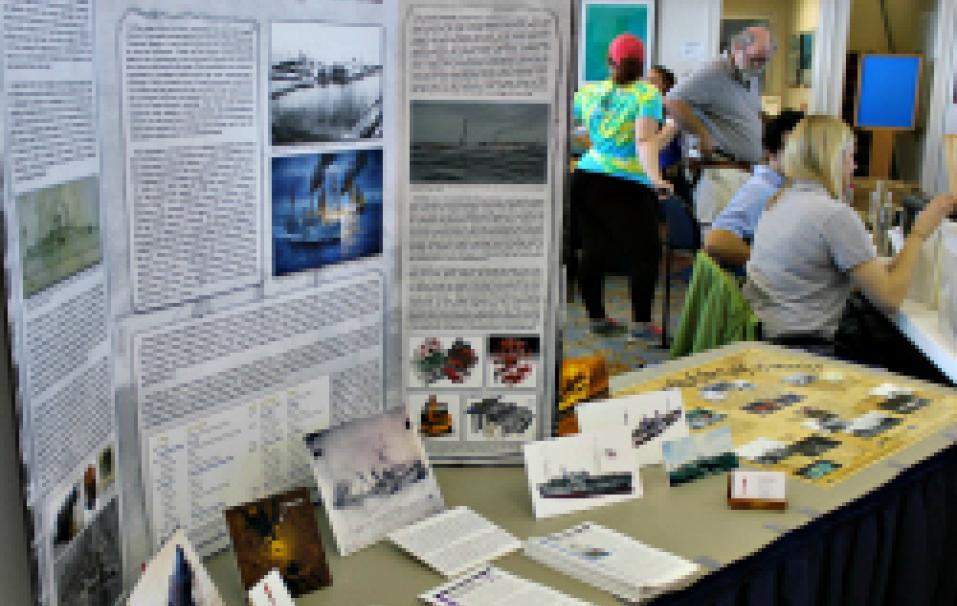By Amy Borgens and Sarah Linden, THC Marine Archeology Program staff
In 2016, we traveled to Galveston to team up with the National Oceanic and Atmospheric Administration’s (NOAA) Flower Garden Banks National Marine Sanctuary (FGBNMS) for the 10th annual family-centered event “Ocean Discovery Day.” The event is designed to introduce visitors to the variety of marine research programs in Texas and the Gulf of Mexico. Visitors were able to visit the sea turtle rehabilitation barn, paint an under-the-sea mural, learn about the history of the marine sanctuary, and participate in a number of marine-related activities. A record number of visitors attended this year’s event, with 4,679 total. More than 3,000 of them perused the educational exhibits and associated children’s activities.
The THC has partnered with NOAA’s Office of Marine Sanctuaries in the past on archeological projects in the Gulf of Mexico, including the investigation of the Monterrey Shipwrecks and the Civil War Union warship USS Hatteras. This is the second time the THC has participated in Ocean Discovery Day, with exhibits focusing on ocean discoveries such as shipwrecks that are yet another of our valuable nonrenewable ocean resources. Such archeological sites degrade over time, and archeologists work diligently to learn how these exciting wrecks touch historic events and breathe life into our knowledge of the past.

In 2016, the THC worked in partnership with the Texas Navy Association and the Maritime Studies Program at Texas A&M University-Galveston (TAMU-G) to host interactive activities and educational displays on maritime history and archeology. Information on Galveston’s Civil War history and archeology was featured, including shipwrecks from the Union fleet (USS Westfield, Hatteras) and Confederate blockade runners (Denbigh, Acadia, Will O’ the Wisp, and perhaps Caroline). The THC presented an exhibit with Bill Turner of the Texas Navy Association that included a tri-fold display and slideshow about the Texas Navy (1836–1845) and its associated Texas shipwrecks (Brutus, Zavala). A table of interactive maritime crafts, such as knot tying and woodworking with shipwright tools, was hosted by TAMU-G professor (and THC Marine Steward Advisor) Tom Oertling and his team.
Another THC exhibit showed video footage of the Monterrey Shipwreck Project recorded in 2013. This exciting offshore project examined three early 19th-century shipwrecks at a depth of 4,300 feet in the Gulf of Mexico, teaming archeologists and scientists from NOAA’s Office of Marine Sanctuaries and Office of Exploration and Research, the Bureau of Safety and Environmental Enforcement, the Bureau of Ocean Energy Management, the Meadows Center for Water and the Environment at Texas State University, and the THC. These vessels may represent a privateer and its captured prizes.

The THC also hosted a children’s activity table as an introduction to marine archeology and shipwreck research concepts. THC staff was assisted by Hunter Brendel, a current NOAA volunteer and former student intern for the THC’s Marine Archeology Program. The kids were able to “excavate” a mock shipwreck and find artifacts in a sand-filled tub. After locating the artifacts, they could draw them underwater like a real marine archeologist using a clipboard, pencil, and tub of water. The kids drew on vellum, a plasticized paper that archaeologists’ use for recording important data while submerged underwater. Kids were also able to experience firsthand what it’s like to do “archeology by braille.” Texas bays, rivers, lakes, and the Gulf of Mexico oftentimes lack the high visibility of tropical areas such as the Caribbean Sea or the Florida Keys. Working in this “black water” environment can be difficult, and marine archaeologists rely heavily on their sense of touch to accomplish many integral tasks while submerged. To provide kids with a similar experience, they were asked to place their hands into a black tub filled with water and plastic zoo animals and guess their identity using just their hands and sense of touch.
The THC is grateful for the invitation from NOAA to participate in this event that celebrates the diverse living ocean—an environment that includes spectacular sea life and the mysterious and sometimes tragic archeological remnants of our past. Ocean Discovery Day was a unique opportunity to promote archeological stewardship and to encourage audiences (both young and old alike) to not only appreciate the importance of preserving and protecting shipwrecks, but also learn how investigations help tell the real stories of these vessels’ place in our history and the lives of those onboard.

